Andrew Skurka's Blog, page 40
February 6, 2018
Preview: Big Agnes AXL Air Pads || Finally, competition for the NeoAir

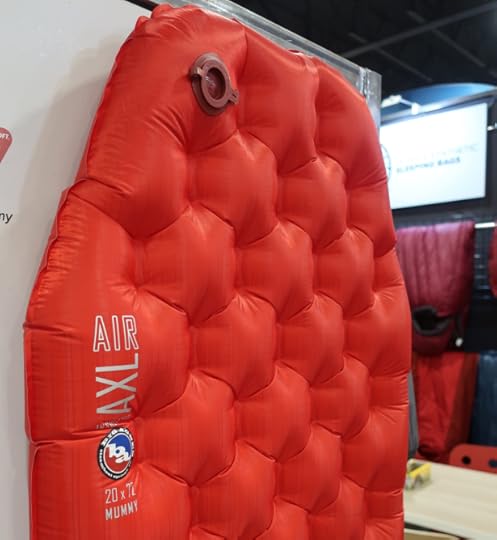
The AXL Air Pad and Insulated AXL Air Pad (photo) are new for Spring 2018 from Big Agnes. They are the first pads to rival and even surpass the specs of the NeoAir.
In addition to the new Tiger Wall UL tent, the other Big Agnes product that caught my attention at Outdoor Retailer was the AXL Air Pad. It’s new for spring 2018, and like the Tiger Wall is available exclusively from REI through May 31. It comes in two versions:
AXL Air ($140, 9.6 oz), for summer conditions and “warm” 3-season campsites; and,
Insulated AXL Air ($180, 11.9 oz), for 3-season conditions and mild winter weather.
Reigning champ: the NeoAir
The AXL is the first sleeping pad that truly competes with the Therm-a-Rest NeoAir XLite which since the late-2000’s has offered an unmatched combination of weight, warmth, and comfort. Some pads are lighter (e.g. a torso-length foam pad), but not nearly as warm or comfortable. Other pads can match or exceed the XLite’s warmth and comfort (e.g. Exped MegaMat 10), but are not in the same weight class.
The XLite version been my go-to for years, and I’ve put hundreds of nights on mine. Besides its price, the chief drawback of the NeoAir is that it crinkles like a potato chip bag. Occasionally, I have heard of and seen delamination issues, but I think the technology has improved with time; plus, there’s a solid warranty behind it.
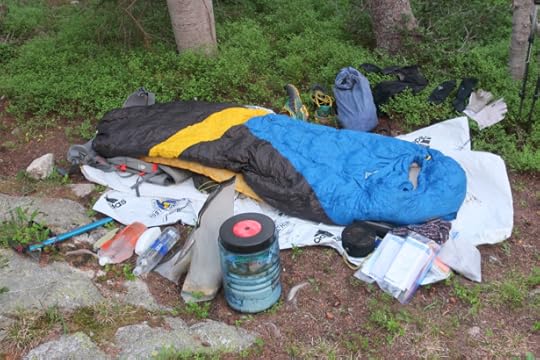
Typical summer camp for me: sleeping under the stars with a quilt or mummy bag, and a Therm-a-Rest NeoAir XLite.
Insulated AXL Air
The Insulated AXL Air goes head-to-head with the NeoAir XLite. They both:
Weigh about 12 oz and cost about $175 for size Regular;
Have R-values of about 3; and,
Give the sensation of sleeping on a potato chip bag.
But in some respects the the AXL ups the ante:
It’s 50 percent thicker than the XLite (3.75-inch max height versus 2.5 inches);
The outer tubes are oversized, to better cradle the sleeper; and,
It should be more stable and even, since it has quilted construction, not horiontal baffles.
The Insulated AXL Air is available in five versions: one mummy-shaped in size Regular, and four rectangular versions with varying widths and heights.
To insulate the sleeper from the ground, the Insulated AXL Air relies on Primaloft Silver synthetic-fill insulation, which is laminated inside to a heat-reflective film. Big Agnes says that it can be inflated by mouth, although in consideration of the volume of air that it holds I might recommend the Big Agnes Pumphouse. I can inflate a 2.5-inch XLite with 13 breaths, so the the AXL will probably take about 20. When camping at 10,000 feet above sea level you might discover the downside to such a thick pad.

Damn, those weights are impressive. Even better: it’s 3.75 inches thick!
AXL Air
Meanwhile, the non-insulated AXL Air seems to be in a league of its own. A 3.75-inch thick pad for 9.6 oz in size Regular? Awesome. Currently, this niche is serviced only by delicate inflatable pool toys and by the Sea to Summit Ultralight Pad, which has an R-value of 0.7 and weighs 13.9 oz in size Regular.
The non-insulated AXL will struggle in non-summer conditions. To supplement its warmth, try:
Using an extra warm sleeping bag;
Layer it over a thin foam pad or extra gear, like a backpack; or,
Using it on soft ground that is less thermally conductive, instead of hard-packed ground.
The AXL Air will be available in fewer sizes than the insulated version, which is probably a good indication of BA’s sales forecasts.

The non-insulated AXL Air Pad is lighter and less expensive, and packs smaller than the insulated version.
Construction
Big Agnes sounds excited about the construction techniques used in the AXL pads. The lamination process uses aviation-grade technology, and the production and quality assurance processes are the same as those used for aviation and medical products. Durability should be good.
Spec comparison
How do the AXL Air and Insulated AXL Air compare to the longstanding reigning champ of 3-season ultralight sleeping pads, the NeoAir XLite?
Questions about the AXL Air Pads? Leave a comment. If I don’t know the answer, I’ll get it from Big Agnes.
Disclosure. This website is supported mostly through affiliate marketing, whereby for referral traffic I receive a small commission from select vendors, at no cost to the reader. This post contains affiliate links. Thanks for your support.
The post Preview: Big Agnes AXL Air Pads || Finally, competition for the NeoAir appeared first on Andrew Skurka.
Preview: Big Agnes Tiger Wall UL 2 & 3 || Best of Fly Creek + Copper Spur
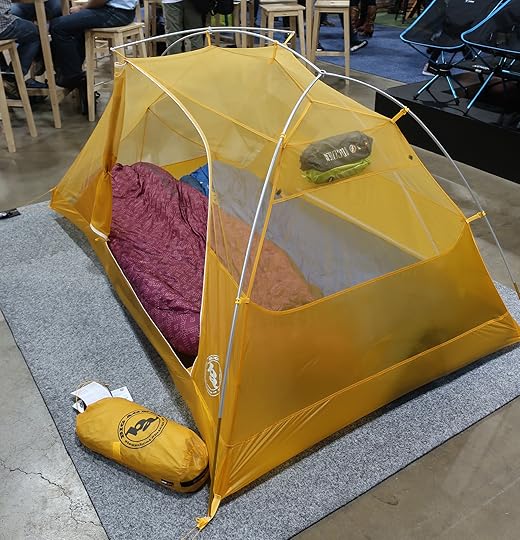
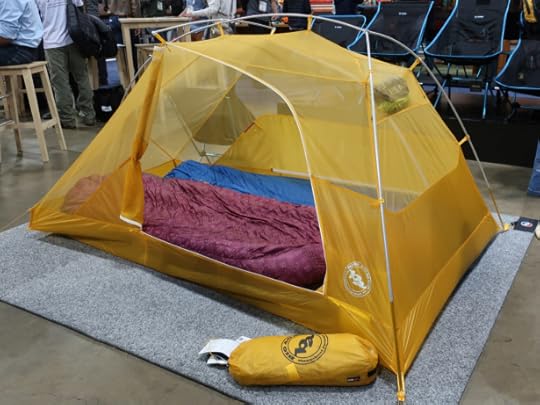
The new Tiger Wall UL tent from Big Agnes is similar to the Copper Spur in that it’s 2-door and 2-vestibule, and more dome-shaped. But its price and weight is more similar to the Fly Creek.
New from Big Agnes for Spring 2018 is the Tiger Wall UL tent. Through May 31 the Tiger Wall is available exclusively from REI, and is available in two sizes:
Tiger Wall UL 2 ($400, 2 lbs 3 oz)
Tiger Wall UL 3 ($450, 2 lbs 11 oz)
The Tiger Wall UL sits between BA’s extraordinarily popular Fly Creek UL and Copper Spur UL series, and combines elements of both. Versus the similarly priced Fly Creek, it’s roomier; the 2-person is 4 oz heavier but the 3-person is 4 oz lighter. Versus the Copper Spur, it’s lighter and less expensive, but has less interior room.
The Tiger Wall UL overlaps with and will probably kill off the Copper Spur Platinum.
Here is the spec comparison:
Geometry
The Tiger Wall is semi-freestanding, like the Fly Creek. The head end is tensioned with a wishbone-shaped pole; at the apex junction, a single pole spans the remaining apex to the foot end. Unlike the Fly Creek, the Tiger Wall has a horizontal pole across the apex pole, to improve interior canopy room at the cost of an ounce or two.
The two-door, two-vestibule shelter is a side-entry, like the Copper Spur. This is much more convenient than the head-entry of the Fly Creek, especially for backpackers who are less able to contort into pretzels during entry and exit. It also allows for greater ventilation, which in addition to campsite selection is the most surefire way to minimize or eliminate condensation.
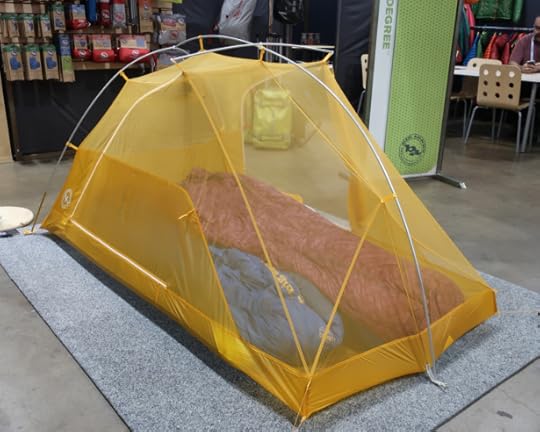
The Tiger Wall is semi-freestanding; the foot corners must be staked out.
In terms of square footage, the Tiger Wall UL meets the minimum standards for 2- and 3-person shelters. But it’s tight, with few inches leftover after inserting two or three 20-inch mattresses. If you use a 25-inch mattress or if you want some extra space, I recommend that you size up, i.e. buy the 3-person even though you’ll only use it with one other person.
In addition to the normal fly/inner setup, the Tiger Wall can be pitched in a Fast Fly configuration, using the fly and the aftermarket footprint (2-person, $70; 3-person, $80). This drops the weight by a few ounces, improves ventilation, and increases interior room, but sacrifices insect protection.
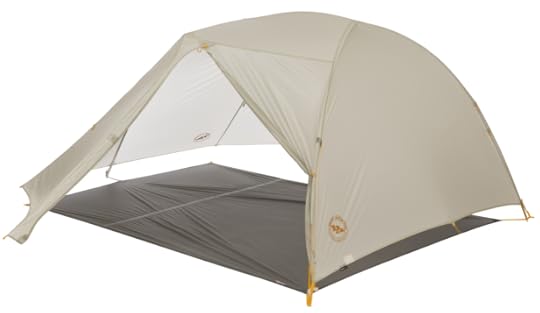
Fast Fly mode
Materials
Big Agnes is known for pushing the limits of material strength and waterproofness in their lightest tents, and they have done so with the Tiger Wall, too. It was apparently toying with a 10d nylon for the fly, but ultimately played it safer with a proven 15d, like with the Fly Creeks. The floor is heavier duty than the fly, at 20d.
The waterproofness of the fly and floor is rated to 1200mm. This sounds low compared to the 4,000 mm HH ratings that are seen nowadays with cottage sil-nylons and DCF fabrics. But it must be adequate — otherwise BA would have received so many returns that it would have changed the spec.
The 2-person version uses 8.7-mm DAC NFL poles, as with the Fly Creeks and Copper Spur Platinum. The 3-person poles are wider diameter, at 9.3 mm.
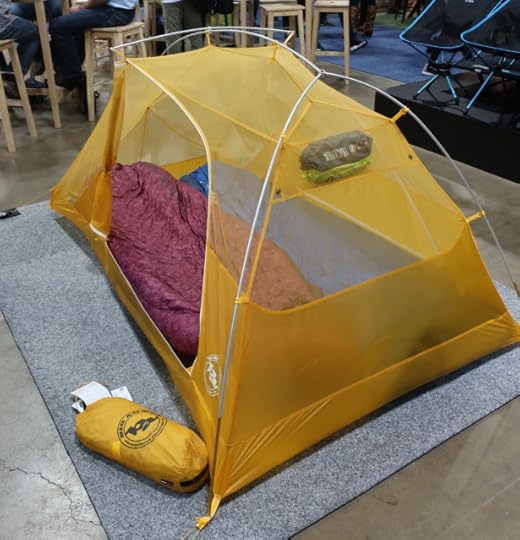
The head end. The horizontal pole across the apex adds considerable interior space relative to the fin-shaped Fly Creek.
Buying recommendations
Without having used the Tiger Wall in the field, here is my reading of Big Agnes’ new product line:
Since the Tiger Wall is only available in 2- and 3-person sizes, a solo backpacker will have to stick with the Fly Creek 1 UL, assuming that they only want a Big Agnes tent and that they aren’t willing to carry a few more ounces for the more generous Fly Creek 2 UL.
For two people, my vote would be the Tiger Wall 2 UL. It’s only a few ounces heavier than the Fly Creek 2 UL, but it offers easier entry/exit, better cross ventilation, and more interior space. This seems like a worthwhile tradeoff. In contrast, the benefits of the Copper Spur (freestanding vs semi-freestanding, and some extra room) don’t seem worth another 8 oz.
For three people, the Fly Creek UL 3 has just one advantage: it’s easier for the middle person to get in and out. Otherwise, the Tiger Wall UL 3 is lighter and has more interior room. The Tiger Wall 3 UL is also significantly lighter than the Copper Spur 3 UL, by 12 oz.
Questions about the Tiger Wall UL? Trying to determine what shelter is best for you? Leave a comment.
Disclosure. This website is supported mostly through affiliate marketing, whereby for referral traffic I receive a small commission from select vendors, at no cost to the reader. This post contains affiliate links. Thanks for your support.
The post Preview: Big Agnes Tiger Wall UL 2 & 3 || Best of Fly Creek + Copper Spur appeared first on Andrew Skurka.
January 31, 2018
Preview: Primus PrimeTech Stove || Stable, efficient group & winter system
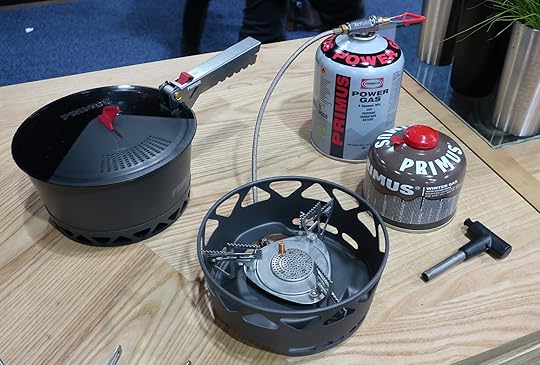

The Primus PrimeTech Stove Set is a stable and very efficient system for groups and winter camping.
Two years ago I shared my five go-to backpacking stove systems, including what I use in the winter and when in a group. These systems are proven, but they’re less efficient than integrated kits, and the a la carte components are less convenient to obtain (and perhaps more expensive) than multi-piece sets.
Last week at Outdoor Retailer, I saw the Primus PrimeTech Stove Set, which appears to rectify some of the imperfections of my recommended kits. It competes against the MSR Windburner Group Stove System, but offers more and is better priced. It is available now, in two pot volume sizes:
PrimeTech 1.3L ($130, 25.6oz)
PrimeTech 2.3L ($140, 30.6 oz)
Each kit includes:
A low-to-the-ground metal windscreen with an integrated burner;
Piezo ignitor;
Two 1.3- or 2.3-liter pots, both made of hard anodized aluminum,
One with a ceramic non-stick coating, and
The other with a heat exchanger around its base;
Transparent lid with integrated colander;
Pot grip; and, a
Stuff sack.
The burner is regulated, so it will better maintain its performance with low-pressure fuel canisters, i.e. that are cold or approaching empty. It specs at 7000 BTU’s per hour, and will burn for 119 minutes on a 230-g/8.1-oz fuel canister.
The pots are “squatty,” which improves fuel efficiency and stability. The 1.3-liter pots spec at 7.1″ in diameter x 4.3″ tall; the 2.3L, 7.9″ diameter x 5.4″ tall.
The entire kit nests together, to make it easily packable.
Personally, I liked most the system’s stable low-the-ground profile and a few thoughtful details, notably the insulated stuff sack that doubles as a pot cozy and the lockable pot grip that can be used as a traditional standalone grip (albiet a more secure one) or that can be attached for the duration of the meal, like a handle.
Versus my recommended kits, the PrimeTech Set is probably a little bit heavier (although I can’t say by how much without breaking apart the 25.6- and 30.6-oz weights into line-items), but it will most definitely be more stable and more fuel efficient. Primus reports that the system captures 80 percent of the fuel’s potential energy, which would make a huge different when melting snow in the winter. The PrimeTech should cost less, too, by about $25 to $50.
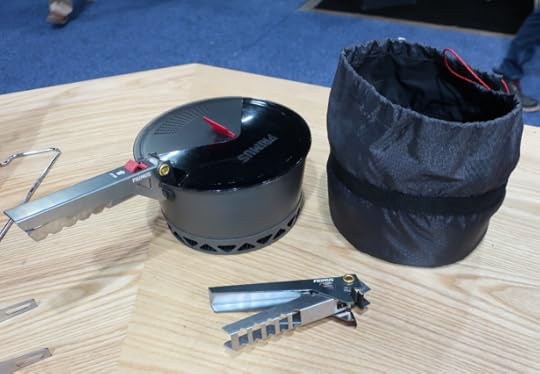
The set has a few thoughtful details, like the stuff sack that doubles as a pot cozy and the lockable pot grip.
Questions about the PrimeTech? Leave a comment. I can get the answers.
Disclosure. This website is supported mostly through affiliate marketing, whereby for referral traffic I receive a small commission from select vendors, at no cost to the reader. This post contains affiliate links. Thanks for your support.
The post Preview: Primus PrimeTech Stove || Stable, efficient group & winter system appeared first on Andrew Skurka.
Preview: Salomon S/Lab Ultra & Ultra Pro, and S/Lab Sense 7 & Sense Pro 3
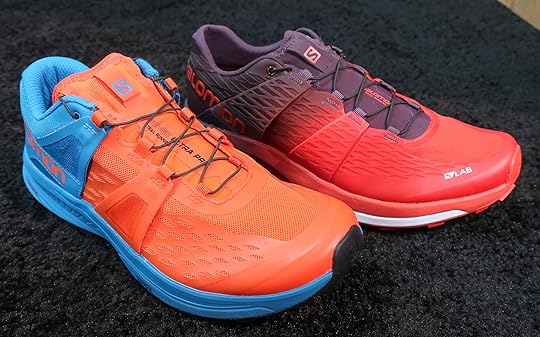
For 2018 Salomon has partially reconfigured the line architecture of its trail running shoes, to better leverage a few success stories and to create space for greater product differentiation. It created an entirely new category, Ultra, and then updated the S/Lab and Pro models in its longstanding Sense line.
Ultra
The new Ultra category is more niche than Sense. It’s designed for longer distances, and therefore has more underfoot protection, more hydrophobic uppers, and more fit adjustments.
Its flagship shoe is the S/Lab Ultra, which is the second-generation S/Lab Sense Ultra (read my review). This shoe was co-developed with François D’haene, who last year proved that he was the best ultra runner in the world by winning UTMB in Septemmber and smashing the John Muir Trail FKT in October (by 12 hours, in 2 days 19 hours and change). Few run like Francois, but apparently many like his shoe — it was Salomon’s best-selling S/Lab trail shoe ever.
I wrote about the S/Lab Ultra after Outdoor Retailer in July 2017. Read that post for in-depth and updated specs. At the time, it was being called the S/Lab Sense Ultra 2. It will be available in March and will retail for $180.
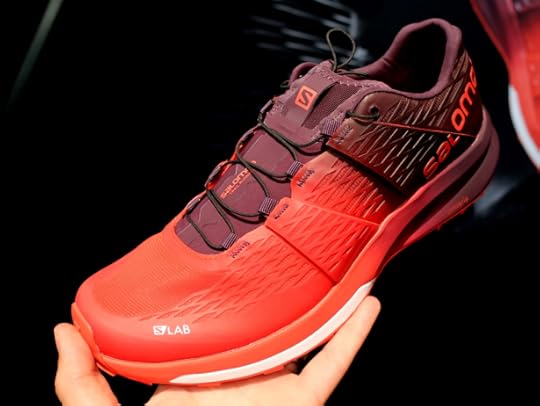
The Salomon Sense Ultra 2, to be released in March 2018
An all-new model, the Salomon Ultra Pro, will be released for fall/winter 2018. It tries to be a more commercialized version of the S/Lab Ultra. Most importantly, it has a lower price point ($150 vs $180), more cushioned heel cup, and more generously fitting upper (especially over the instep).
Unlike the first-generation S/Lab Ultra, the Ultra Pro does not have a rock plate, which is a big reason why it’s lighter. Feedback was that the resilient TPU-based EnergySave midsole was sufficient. It shares the same outsole compound and upper material.
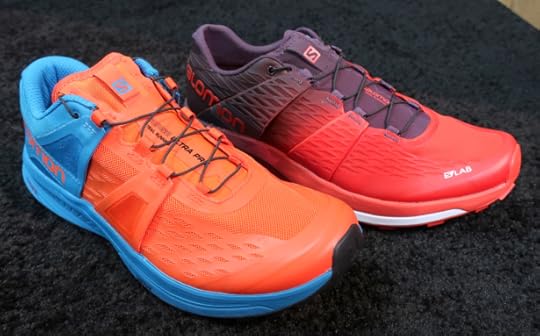
The S-Lab Ultra (right), the second-generation of the S/Lab Sense Ultra and formerly called the S/Lab Sense Ultra 2; and the all-new Ultra Pro (left), a more commercialized version
Key specs of the Ultra Pro:
10.3 oz (US 9M) / 8.8 oz (US 7W)
24mm/16mm (8mm drop)
Premium Wet Traction Contragrip outsole, with 4mm lugs
TPU-based EnergySave midsole
3D Stretch Air Mesh with Sensifit upper
$150 MSRP
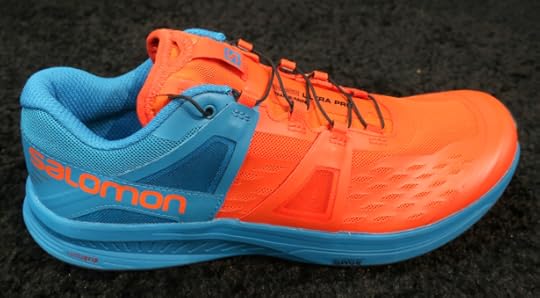
Ultra Pro
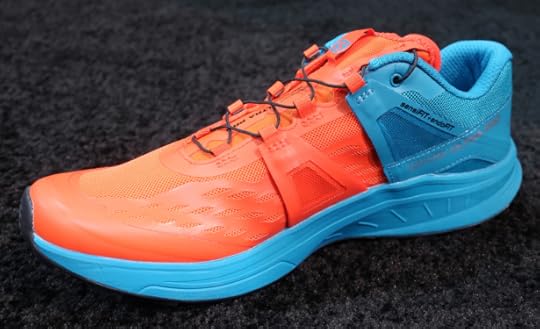
Ultra Pro upper, made with hydrophobic materials and featuring two external fit wings
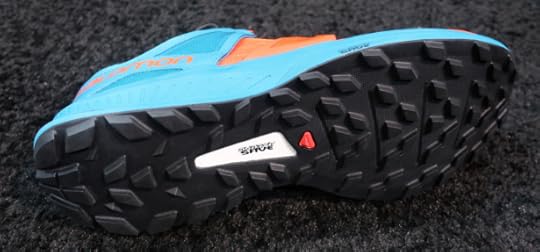
Ultra Pro outsole, made of Premium Wet Traction Contragrip
Sense
The consensus at Salomon was that the current S/Lab Sense 6 strayed too far from its roots as “the Kilian shoe” — a minimalist racer for featherweight runners with perfect biomechanics. The S/Lab Sense 7 hits that mark. The unisex Sense 7 will be available this fall/winter in two outsole versions, the Hard Ground and more aggressive Soft Ground.
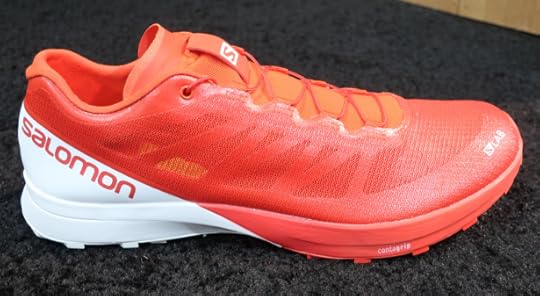
The minimalist upper on the new S/Lab Sense 7
Key specs of the S/Lab Sense 7:
Weight: 7 oz (US 9M)
18mm / 14mm (4mm drop)
Premium Wet Traction Contagrip outsole
Profeel Film chassis
EnergyCell+ and Dual Density Compressed EVA midsole
Integrated sockliner
$180 MSRP
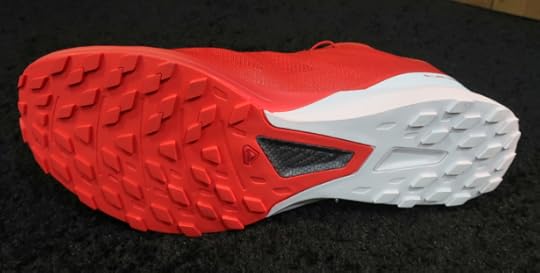
The Soft Ground outsole on the updated S/Lab Sense 7
The S/Lab Sense 6 may not have made a good shoe for Kilian, but it worked better for the rest of us. So Salomon reconfigured it as the new Sense Pro 3. I’m told that it runs more like the original Sense Pro, but has a more aggressive outsole akin to the Sense Pro 2. I considered the latter a bit stiff, and found it best for technical trails only; whereas I was willing to run just about anywhere with the Sense Pro.
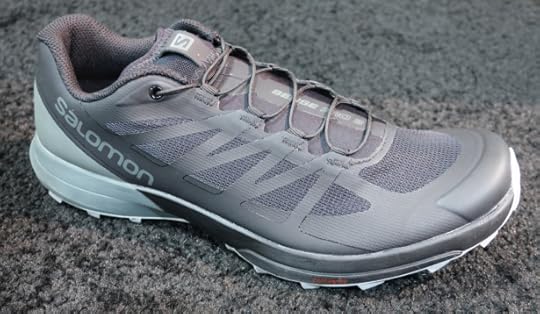
The new Sense Pro 3 is a reconfiguration of the S/Lab Sense 6
More specs on the Sense Pro 3:
Weight: 8.9 oz (9M) / 7.9 oz (US 7W)
20mm / 16mm (4mm drop)
Premium Wet Traction Contagrip
Profeel Film chassis
EnergyCell+ midsole
Molded EVA sockliner
$130 MSRP
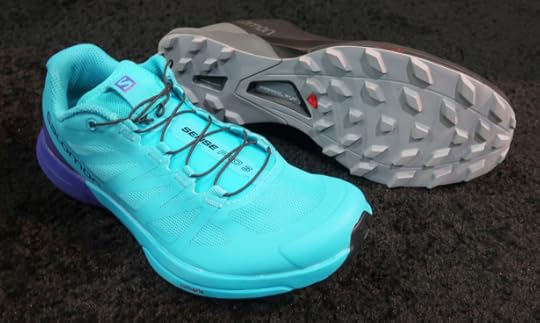
The upper and outsole of the new Sense Pro 3 look familiar.
Questions about the S/Lab Ultra, Ultra Pro, S/Lab Sense 7, or Sense Pro 3? Leave a comment.
Disclosure. This website is supported mostly through affiliate marketing, whereby for referral traffic I receive a small commission from select vendors, at no cost to the reader. This post contains affiliate links. Thanks for your support.
The post Preview: Salomon S/Lab Ultra & Ultra Pro, and S/Lab Sense 7 & Sense Pro 3 appeared first on Andrew Skurka.
January 30, 2018
Preview: Western Mountaineering Nanolite & Astralite || Premium UL quilts
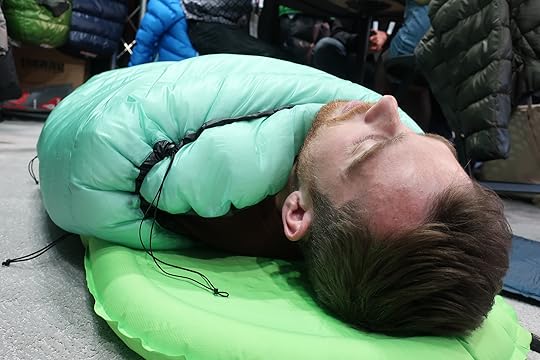
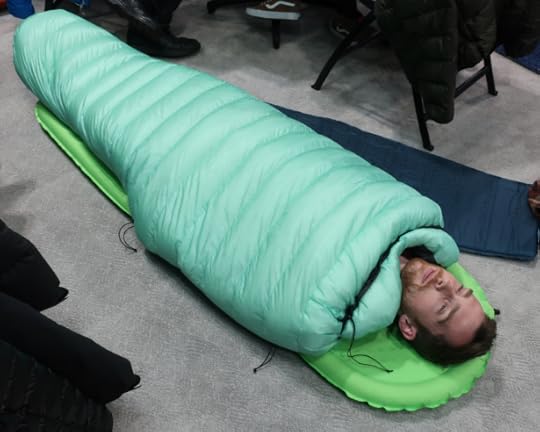
Western Mountaineering enters the quilt category in spring 2018 with the 38-deg Nanolite and 26-degree Astralite.
Western Mountaineering is known for not chasing trends and for being supremely loyal to its retailers. So the news that it’s offering a sleeping quilt for spring 2018 says two things to me:
Quilts are not a fad, and have perhaps reached critical mass; and,
WM retailers became convinced — by either a compelling WM pitch or, more likely, customer inquiries — that there is a market for quilts.
Western’s new quilt is, of course, a beautiful product that is made of premium materials (notably, 850+ European down and 7d & 10d fabrics) and that appears masterfully constructed. You don’t expect less of WM. The quilt is available in two temperature ratings in two sizes (up to 6’0″ and 6’6″):
Nanolite ($330, 11 oz), rated to 38 degrees F
Astralite ($400, 16 oz), rated to 26 degrees F
The quilts were not EN tested, but WM ratings are considered among the most conservative.
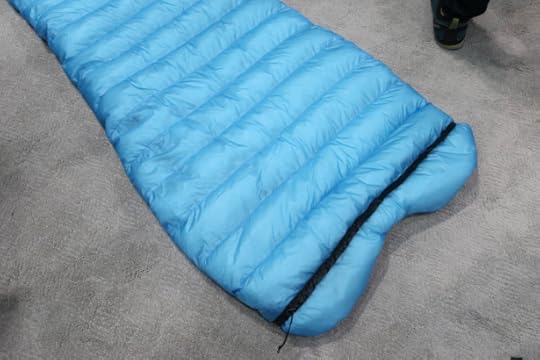
The “passive top collar” is contoured in such a way as to reduce drafts around the neck, especially when cinched.
Materials
The Nanolite and Astralite have the same 850+ fill power European down that is used in all WM products, including apparel like its lovely Hooded Flash Jacket and Flash Pants. It’s a time-tested commodity, and I’d be skeptical to believe that any familiar brand is using high quality down, including those that claim 900 fp. WM continues to use untreated down, believing that the large clusters and natural oils in its down offer sufficient resistance to moisture.
The shell fabric is a proprietary 7d with an acrylic kiss coating for added durability. WM had it milled specifically for these quilts, but may begin to use it in other products once they have more long-term feedback. The liner is a 10d taffeta.
Design
The quilt’s dimensions are based on the Western Mountaineering Ultralight, which John from WM described as being a “performance cut mummy bag.” It specs at 59 inches at the shoulder, 51 inches at the hip, and 38 inches at the footbox; the larger size is one inch wider at the shoulder and hip.
The footbox is sewn closed, eliminating the option of opening the Nanolite or Astralite into a rectangular quilt.
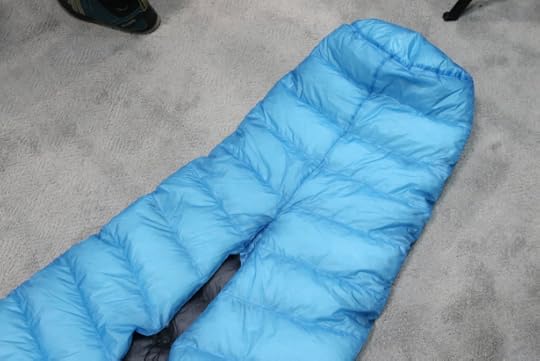
Sewn footbox
The back closure system on their sample bags at Outdoor Retailer was a rat’s nest of bungee cord, but I was told that production would have three strips of 1/2- or 3/4-inch grosgrain webbing, probably similar to those on the Enlightened Equipment quilts.
As I watched John squirm into a quilt that was attached to a pad, I questioned this feature. Personally, I remove the attachment system, because I don’t like feeling as if I’m strapped to a backboard. And if I want a draft-free sleeping experience, I know of a much less fussy way to get it. It’s called a mummy bag.
The most interesting design feature is the contoured “passive neck collar” that can be cinched with an exterior bungee cord in order to minimize drafts around the neck. The seal did not appear as effective as, say, the hide-away hood on the Sierra Designs Backcountry Quilt, but the comparably rated Nanolite is less than half the weight of the BCQ.
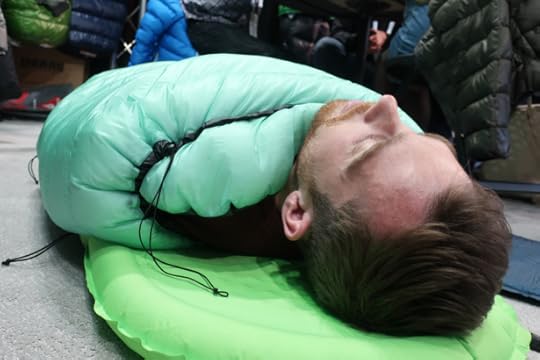
Especially when cinched, the contoured top color will help to reduce drafts around the neck. But it still does not seal as well as a mummy or hide-away hood.
Comps
How do the Astralite and Nanolite stack up against other premium quilts from cottage brands like EE, Katabatic, and ZPacks? In terms of features and materials, they didn’t strike me as being exceptionally better or different. And the WM quilts seem marginally more expensive versus quilts of comparable warmth and size.
But it may not matter. WM sells only to retailers, not direct, so customers that want to support their local retailer or who want to try before they buy will be limited to the WM quilts.
Questions about the Nanolite or Astralite? Leave a comment.
Disclosure. This website is supported mostly through affiliate marketing, whereby for referral traffic I receive a small commission from select vendors, at no cost to the reader. This post contains affiliate links. Thanks for your support.
The post Preview: Western Mountaineering Nanolite & Astralite || Premium UL quilts appeared first on Andrew Skurka.
Sneak peak: Ultimate Direction Scram || Anton Krupicka scramble pack
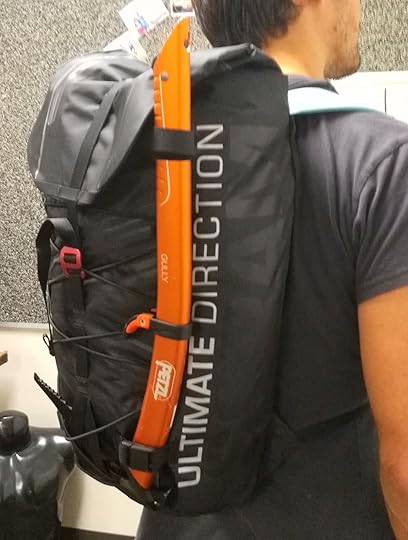
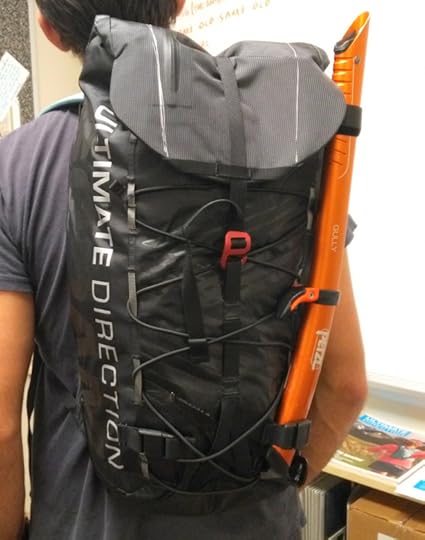
The Ultimate Direction Scram is a 20-liter scrambling-inspired daypack that will be available in Spring 2019.
After a Sierra Designs meeting this morning (re updates to the High Route Tent for 2019), I swung through the Ultimate Direction area to ask about the new pack they are designing with the ridiculously fit but chronically injured Anton Krupicka. None of the Exxel Outdoors brands — notably SD, UD, Kelty, and Slumberjack — had booths at the recent Outdoor Retailer, so I didn’t get a chance to see it there.
The Ultimate Direction Scram will be available in Spring 2019 and retail for $135. The prototypes look pretty good already and it seems like the launch could be bumped up, but spring 2019 sounded firm. Key specs:
20 liters
16 oz total weight
Two sizes: S/M and M/L
Black with gray accent color
70d nylon main pack body fabric, with 200d x 120d bottom
1 exterior pocket, on the top lid flap
The Scram goes head-to-head against the Black Diamond Blitz 20. UD offers shoulder strap pockets, a compression-molded back panel, a ski carrying system, and a rear cinch cord for compression and utility. But the Blitz is $55 less and is made of more durable fabric.
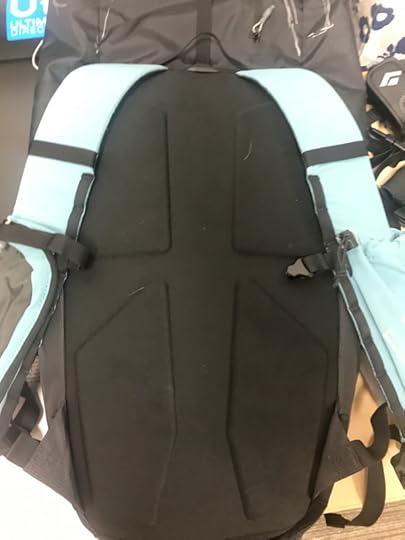
The firm back panel is made of compression-molded foam.
Harness
The Scram does not retain the “vest” design from Anton’s other pack, the Ultimate Direction AK Mountain Vest. Instead, it looks like a more traditional “stuff sack with shoulder straps,” although it’s more sophisticated than that.
The back panel is made of firm compression-molded foam, which will help to blunt the pressure of hard-sided contents packed inside (e.g. a climbing rack).
The shoulder straps are wide and padded, and there is a pocket on both. One is designed for a water bottle, and the other can be zipped shut.
The hip belt appears to be 30-mm webbing, and it’s fully removable.

The wide, padded shoulder straps both have pockets.
Fabrics
The pack bottom is made with a more durable unbranded 200d x 120d nylon that has a “a crazy tear strength.”
The main pack body is made of a lightweight 70d nylon. For a pack designed for playing in rocky environments, I fear this is “stupid light.” Presumably Anton is using the pack regularly and will find weaknesses in it, but at least intuitively I would prefer that the pack be made entirely of something heavier, like the bottom fabric. On a 20-liter pack, this fabric substitution would probably add only a half-ounce. To their credit, UD has protected some of the 70d fabric with printed graphics, which essentially acts like a coating.
The pack body is made of 70d nylon; the bottom, out of more durable 210d.
Trims
Two ice axes can be attached to the Scram. The upper shaft is held in place with a conventional Velcro loop. The lower attachment point is more unique: it’s a magnetic closure that opens easily when pinched, but otherwise is very secure. The ice axes can be accessed without taking the pack off.
The Scram can carry a pair of lightweight skis, using an attachment system similar to that on the Ultimate Direction SkiMo 8 Pack.
A bungee cord on the rear of the pack double as compression and utility.
Finally, the removable top lid strap has two possible anchor points: at the top of the shoulder straps, for normal loads; and at the lower lip of the top strap, for when the lid can’t wrap around an oversized load or climbing rope.
Questions about the Ultimate Direction Scram? Leave a comment. If I don’t know the answer, I’ll get it from UD.
Disclosure. This website is supported mostly through affiliate marketing, whereby for referral traffic I receive a small commission from select vendors, at no cost to the reader. This post contains affiliate links. Thanks for your support.
The post Sneak peak: Ultimate Direction Scram || Anton Krupicka scramble pack appeared first on Andrew Skurka.
January 29, 2018
Buyer’s Guide: Kathoola Microspikes vs K-10 and KTS Crampons || Differences, intended uses, and limitations
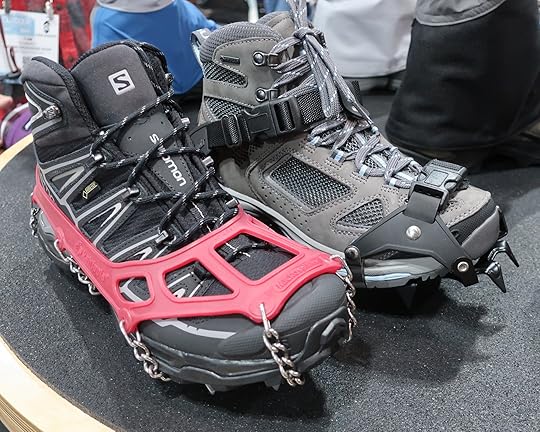
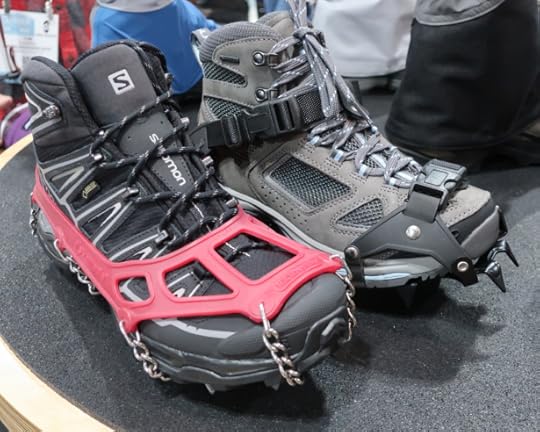
The Microspikes (left) are best for ice and consolidated snow. They are also light, reasonably priced, and easy to put on and take off. The K10 Crampons are more suitable for steeper slopes and softer snow.
Kahtoola was showing off its new gaiters at the Outdoor Retailer tradeshow, but I was more interested in its time-tested traction devices. These spikes and crampons are crux for:
Running on snow- and ice-covered trails and roads; and,
Hiking on glacial ice, crust-covered snowpack, or steep-ish lingering snowfields.
All the Kahtoola devices are compatible with soft-soled boots and shoes. Unlike conventional crampons, they do not require a stiff sole or a special heel piece. This makes them ideal for runners and hikers who prefer to wear soft, comfortable shoes.
I traded stories and insights with Ric from Kahtoola to better understand the differences, intended uses, and limitations of these products.
Kahtoola Microspikes
$70
12 oz +/- depending on the size
Four sizes
Twelve 3/8-inch spikes
More information
Nearly every trail runner in Boulder owns the Kahtoola Microspikes. They are lightweight and compact, quick to put on and take off, and very effective on ice and compacted snow. Especially at the higher elevations and on shady aspects, Boulder’s foothills trails can become luge runs or skating rinks during the winter. Running or hiking without Microspikes is an invitation for a concussion, or just simply impossible.
For pure ice, the Kahtoola Nanospikes work equally well. But they struggle in any kind of snow, and therefore are not as popular.
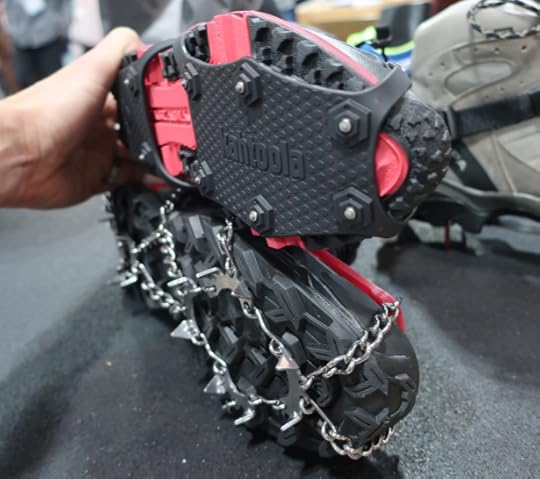
The Nanospikes (top) work well on ice, but don’t offer enough bite for snow.
The Microspikes have been worn successfully by backpackers on the Wind River High Route, which requires non-technical glacier travel (i.e. no ropes or crevasse risk), and on popular long-distance trails in early-season conditions like the Pacific Crest and John Muir Trail. Imagine, for example, trying to climb or descend an established boot track up to or down from a 12,000-foot pass early in the morning before the snow has softened up.
In unconsolidated snow and soft spring snow, the 3/8-inch spikes reach their limit, unable to provide reliable purchase. They would be a poor pick for, say, the Sierra High Route, which gets much less traffic (and therefore has no boot tracks) and tackles steeper terrain. It certainly can be done, but Microspikes would not be a first-choice.

The Micropikes (top) versus the K10 Crampons
Kahtoola K10 Crampons
$100
21.5 oz
One size
Ten 3/4-inch spikes
More information
The K10 are ideal for hiking on steep-ish slopes in early-season conditions, especially on routes without established boot tracks: the longer 3/4-inch spikes bite better than the Microspikes into softer, less consolidated snow.
What does “steep-ish” mean? Personally, I’ll get on slopes up to about 45 degrees, but my tolerance is probably higher than most.
The sharp steel spikes of the K10 will stick to compacted snow and ice just as well as the Microspikes. However, they’re almost twice as heavy, more time-consuming to put on and take off, and less comfortable to wear than the Microspikes. So they’d be overkill for Boulder’s foothills trails and for the John Muir Trail in most years.
The K10 Crampons are available commercially in just one size. It will fit men’s hiking boots between sizes 6 and 13, and women’s in 7 to 14. If you use a trail running shoe, you can probably have a bigger size (maybe up to 14 in men’s and 15 in women’s); if you wear a large boot, it’s the reverse. If you fall outside these ranges, contact Kahtoola for a LeafSpring Flex Bar in size XS or XL.
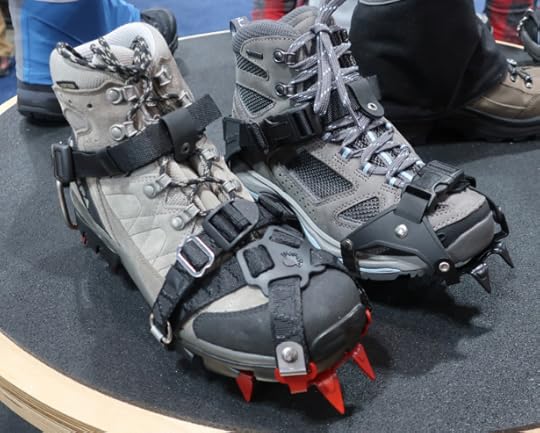
The K10 Crampons (right) are simpler, lighter, and less expensive than the KTS. For most early-season backpacking, they are the more appropriate pick.
KTS Crampons
$170
23.3 oz
One size
Ten 1-inch spikes
More information
The original Kahoola product is slightly more capable than the K10 Crampons, with 1-inch spikes, a trianguled buckle closure system, and a more engineered heel piece. But the KTS Crampons are excessive for nearly all backpackings. Moreover, it’s a few ounces heavier and $70 more expensive than the K10. It’s better suited for lightweight mountaineering.

The K10 has a simpler heel, part of why it retails for $100 instead of the $170 for KTS.
Have questions about or an experience with Kahtoola products, or with similar ones? Leave a comment.
Disclosure. This website is supported mostly through affiliate marketing, whereby for referral traffic I receive a small commission from select vendors, at no cost to the reader. This post contains affiliate links. Thanks for your support.
The post Buyer’s Guide: Kathoola Microspikes vs K-10 and KTS Crampons || Differences, intended uses, and limitations appeared first on Andrew Skurka.
January 26, 2018
Preview: Altra Lone Peak 4.0 || More durable upper & new stickier outsole
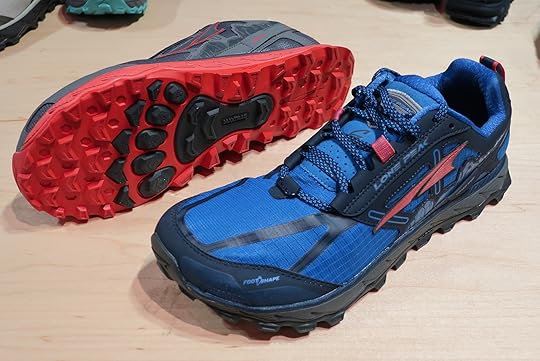
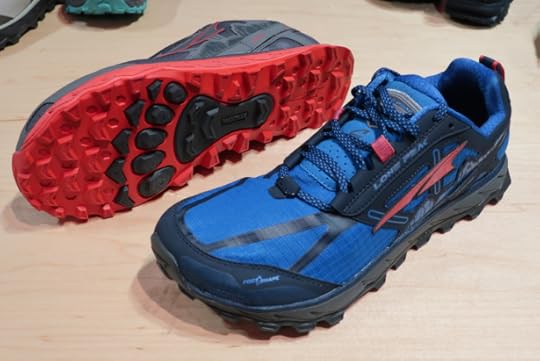
The next-generation Altra Lone Peak 4.0, which will be available in August 2018. If the Lone Peak 3.0 or 3.5 worked for you, the 4.0 will probably, too.
At the Altra booth I found the Lone Peak 4.0, the next-generation of this popular trail running and thru-hiking shoe. It will be available in August 2018, and in four versions:
Low Mesh ($120, 10.2 oz for M’s, 8.7 oz for W’s)
Mid Mesh ($130, 12.3 oz for M’s, 10.3 oz for W’s)
Low RSM ($150, 10.9 oz for M’s, 9.9 oz for W’s)
Mid RSM ($160, 12.9 oz for M’s, 11.3 oz for W’s)
RSM stands for “rain, snow, and mud.” More commonly, these shoes are described as “waterproof,” which is a mischaracterization but is what it is. The RSM models will use eVent fabric, not Polartec Neoshell like the 3.0 waterproof version.
For almost an hour I spoke with the founder of Altra, Golden Harper, about the differences between the four 4.0 versions and also between earlier generations of the Lone Peak. Golden struck me as such a nice a guy that I might never say anything remotely negative about his company or products again.
Hesitant updates
The Lone Peak has been hugely successful for Altra. It’s the best-selling trail shoe in the run speciality market, the best-selling non-Salomon trail shoe in the outdoor non-speciality market, and now the most popular shoe on the Appalachian and Pacific Crest Trails, having surpassed the Brooks Cascadia.
Altra knows of changes that should be made to the Lone Peak, but it is careful in doing so. Some so-called improvements could cause a rebellion by the shoe’s fan base.
Overall, the changes made to the four-generation Lone Peak are probably less significant and fundamental than past generational updates. If you liked the Lone Peak 3.0 or Lone Peak 3.5, you will probably also like the Lone Peak 4.0, and odds are that you’ll probably like it more.
Outsole
The biggest change to the Lone Peak 4.0 is the outsole. Altra considered using Vibram MegaGrip, but to save cost it ultimately chose a proprietary style, branded as Maxtrac. Even so, the raw expense of the outsole is still about twice that of the outsole on the 3.0 and 3.5.
The new rubber compound is grippier and more durable. The lugs are more aggressive and less prone to being sheared off by sharp rocks, and constitute a greater volume of rubber.
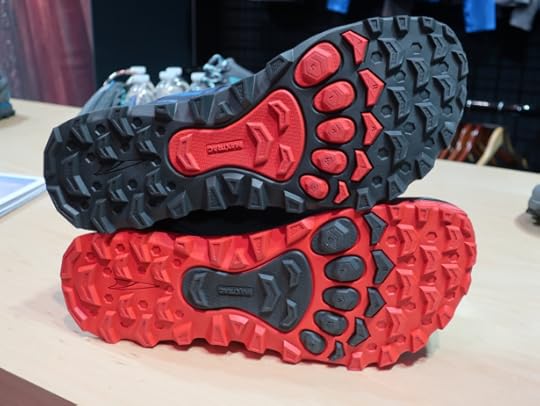
The all-new outsole is made of more durable and better gripping rubber, and it has more lug volume.
Midsole
Less wholesale changes were made to the midsole. The last, 25-mm stack height, and foam firmness (or “durometer,” in shoe geek speak) are unchanged.
The tapering of the midsole thickness from the ball of the foot to the toes is now more aggressive. This results in more rocker and a quicker toe-off.
The TPU StoneGuard rock plate is no longer just a plain insert, but replicates the bone structure in the foot, i.e. long, independent metatarsals. The rock plate sits atop the midsole, under the foam insole. The new design should offer comparable underfoot protection, but with more flexibility.
Upper
Altra has struggled with the durability of the upper in the Lone Peak, especially the 2.5 and 3.0. With the 4.0, they sought out a mesh that appears almost identical to that used in the Salomon Speedcross, which is a proven material. I was told it has more stretch and is less boardy, however.
A V-shaped overlay surrounds both sides of the midfoot, which should improve lateral and fore/aft control. Harper believes the 4.0 will fit more securely than any previous generation of the Lone Peak.
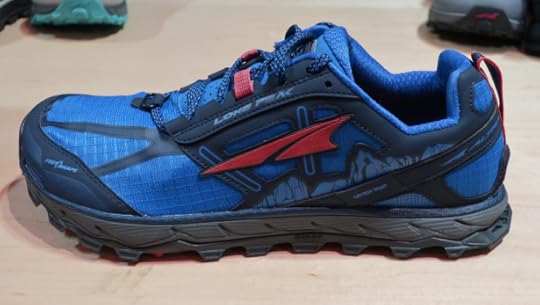
Lateral side. Notice the V-shaped overlay that will help to secure the midfoot. According to Harper, the 4.0 should be the most secure Lone Peak ever.
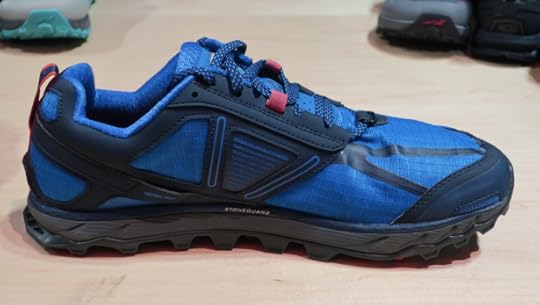
Medial side.
The upper has been optimized for ventilation and water drainage. The moderately padded tongue is perforated. The toebox is made of single-layer mesh, not the customary double-layer. And the toe cap has two drain ports, to reduce the pooling of water inside the shoe after submersion.
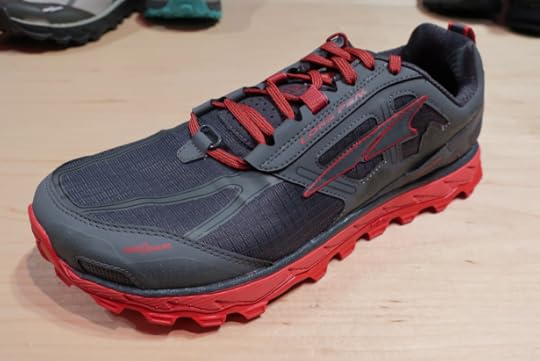
The toe cap has drain ports on each side to allow water out of the shoe after submersion.
Gaiters
The Lone Peak retains the GaiterTrap and lace loop, which work with Altra’s gaiters and some other varieties, notably Dirty Girl. Two additional anchor points were added, however, to achieve downward tension on each side of the gaiter without using in-step strap.
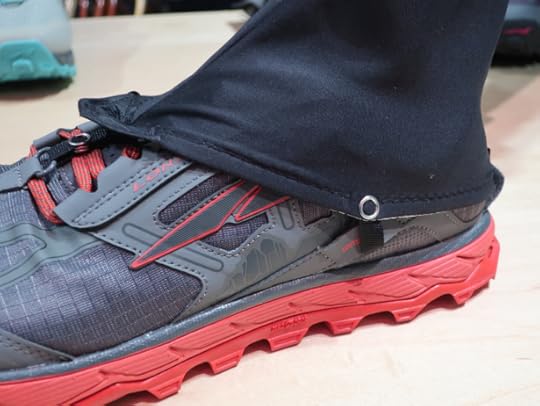
Two additional anchor points were added to Altra’s gaiter attachment system. These additional side anchors prevent the need for an in-step strap, while still providing downward tension.
Fit
As previously mentioned, the 4.0 shares the same last (or foot shape) as the 3.0 and 3.5. The toebox is a little bit more open, but the midfoot and heel are slightly narrower. Generally speaking, if the 3.0 and 3.5 fit you well, the 4.0 will fit well, too.
The heel counter is back-less, which should make the 4.0 friendlier to odd-shaped feet and to those with chronic Achilles problems. Unlike with a normal heel counter, the very rear of the shoe is not stiffened with plastic.
Version differences
Besides the cuff height, the low and mid versions have a few other differences. Altra expects the mid to be more popular among hikers and backpackers, so the changes are aimed at this application.
1. The outsole on the mid uses more carbon-based rubber, which will make it more durable but less grippy.
2. The mid heel is more reinforced, providing additional stability for heavier loads and perhaps more rugged terrain.
3. The midsole is “a little bit firmer,” according to Harper, enough to be noticeable. This should make the midsole more resilient, too, instead of feeling “thin” after just a few hundred miles.
With the RSM versions, several changes will help make them more weather-resistant. The drain ports in the toe cap were eliminated, for example, and the GaiterTrap was redesigned to create a better seal.
Have questions about the 4.0? Leave a comment.
Disclosure. This website is supported mostly through affiliate marketing, whereby for referral traffic I receive a small commission from select vendors, at no cost to the reader. This post contains affiliate links. Thanks for your support.
The post Preview: Altra Lone Peak 4.0 || More durable upper & new stickier outsole appeared first on Andrew Skurka.
Preview: Sea to Summit Alpha Series Cookware || Remarkably thoughtful
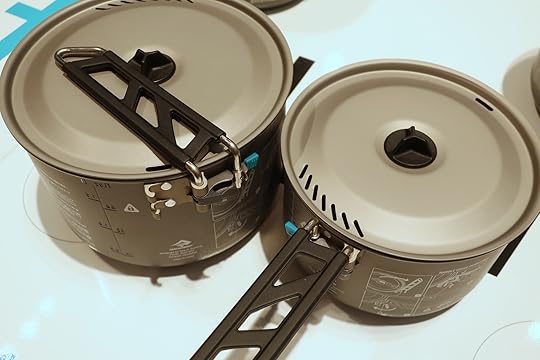
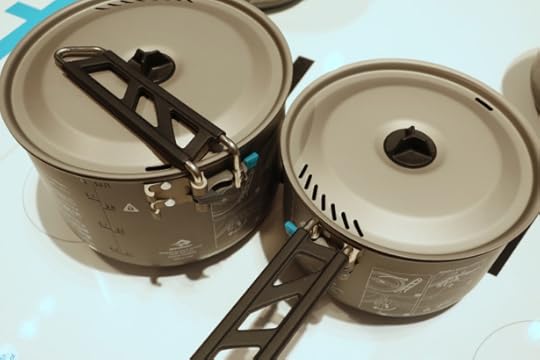
The Pivot-Lock handle is among the most thoughtful feature of a generally thoughtful product. It serves as a sturdy pot grip and keeps the lid secured to the pot during storage.
So much thought went into the new Alpha Series Cookware from Sea to Summit that I feel compelled to write about it. The retail prices and weights are very good, but I was most impressed with the attention to detail and the willingness to look with fresh eyes at an otherwise tired category.
The Cookware is available as standalone pots and as cookset systems.
Alpha Series Pots
The series consists of four pots:
1.2L ($35, 6.6 oz)
1.9L ($40, 8.1 oz)
2.7L ($45, 9.6 oz), and
3.7L ($50, 11.9 oz).
All are made of hard anodized aluminum, which is slightly heavier and less durable than titanium of comparable thickness, but notably less expensive. Aluminum also better conducts heat. The interior of the pots are not non-stick.
There is also an 8- and 10-inch fry pan, for $35 and $40.
Attached to each pot and pan is a non-removable Pivot-Lock (TM) handle, which serves as a sturdy pot grip and which keeps the pot lid in place during storage. The system is probably heavier than a standalone grip or conventional pivoting handle, but many will consider the convenience and functionality worthwhile.
The thoughtfulness extends to the pot lid, which has a steam port, water strainer, and siliconized rubber piece that serves as a three-finger grip on one side and a pot tab on the other. The lid rests inside the rim of the pot, to eliminate tension or friction between the two pieces.
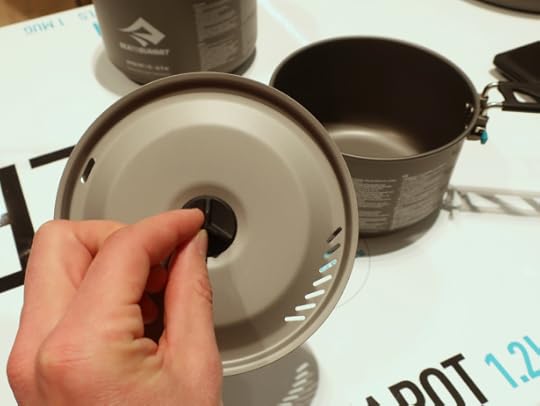
The lid has a steam port, strainer, and a siliconized rubber tab that doubles as a gripper and a pot rester.
Alpha Series Cooksets
I found the cooksets even more entertaining. They are packaged as:
Cookset 1.1 ($45), with the 1.2L pot and one setting;
Cookset 2.1 ($65), with the 1.9L pot and two settings;
Cookset 2.2 ($90), with the 1.9L and 2.7L pots, plus two settings; and,
Cookset 4.2 ($120), with the 3.7L and 4.7L pots, plus four settings.
Each setting includes a:
Mug, with a cozy and insulated cap; and, a
Plastic eating bowl, with shallow corners for easier calorie-scraping.
The 1.2L pot is accompanied by a 1-person setting.
The sizes of the eating bowls in the multi-person settings are graduated, so that they nest completely inside of each other. Also, the bowls and mugs come in different colors, so that “his” and “hers” are easy to differentiate.
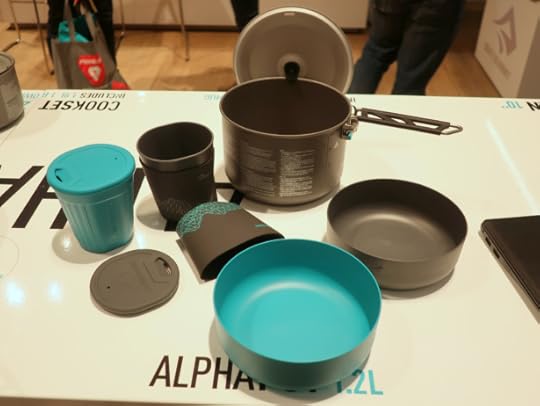
A 2-person cookset, with nesting eating bowls and color-coded mugs.
Questions about the Alpha Series Cookware? Leave a comment. If I don’t know the answer, I’ll get it from Sea to Summit.
Disclosure. This website is supported mostly through affiliate marketing, whereby for referral traffic I receive a small commission from select vendors, at no cost to the reader. This post contains affiliate links. Thanks for your support.
The post Preview: Sea to Summit Alpha Series Cookware || Remarkably thoughtful appeared first on Andrew Skurka.
January 25, 2018
Osprey Levity/Lumina vs. Exos/Eja: What will you sacrifice for 12 oz?


The new Osprey Levity/Lumina is about 12 oz lighter than Osprey’s previous lightest backpacking pack, the Exos/Eja. But it sacrifices performance, durability, and price to make that happen.
This spring Osprey has released a new backpack design that is aimed squarely at the ultralight and thru-hiking communities. It’s available in men’s and women’s sizes, each in two volumes:
Levity 45 and
Levity 60 for men; and,
Lumina 45 and
Lumina 60 for women.
For many years, Osprey’s answer for these backpackers has been the men’s Exos 38, 48, and 58 and the women’s Eja 38, 48, and 58.
At Outdoor Retailer I spoke with Chris Horton, a Product Line Manager for Osprey who was involved in the development of the Levity/Lumina, about the major differences between these two packs, in terms of design and intended uses.
Overview
The Levity/Lumina is lighter, but less durable, $50 more expensive, and comfortable only up to about 30 pounds. It’s stripped down to the essentials, and some of its remaining features seem fussy, like tiny side-release buckles and 2mm compression strap cords. It’s designed for experienced, gram-conscious backpackers who want Osprey’s renowned fit and AirSpeed suspension.
The Exos/Eja is about 12 oz heavier, but more durable and less expensive. Its comfort limit is about 40 pounds, thanks to more cushioned body/backpack contact points. It has several nice-to-have features, like ice axe loops and a removable top lid; and its other features are often more user-friendly, like webbing compression straps and a sliding sternum strap. It’s a durable and reasonably priced ultralight pack that is suitable for beginner and veteran backpackers alike.
Weight
The headline story about the Levity/Lumina is their weight: in all sizes, the 45L and 60L are less than 2 pounds. As one specific example, in size medium the Levity 40 is 1 lb 13 oz and the Levity 60 is 1 lb 15 oz.
On average, the Levity/Lumina are about 12 oz lighter than an Exos/Eja of comparable volume, which is a decrease of about 25 percent. The exact difference will vary with volume and size.
Of course, everything is a tradeoff. In the case of pack design, weight-savings are normally at the expense of performance, durability, and/or price. To shed those 12 oz, Osprey had to make sacrifices in all of these regards.
Load carrying
The Levity/Lumina and Exos/Eja share the same load-support system, Osprey’s AirSpeed Suspension. It tensions a mesh back panel across a peripheral frame made of spring steel to create an air channel between the wearer and pack bag.
The main compartments are similarly proportioned, therefore have a similar balance and ride.
The mesh back panel on the Levity/Lumina is lighter than on the Exos/Eja. But to maintain durability, the mesh is less porous and air permeable.
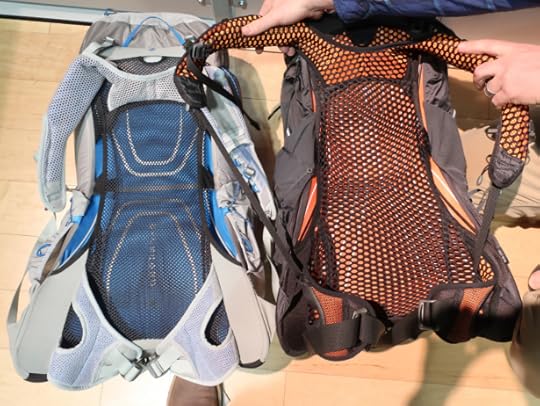
The Levity and Exos both have Osprey’s AirSpeed suspension. The Levity uses a lighter mesh, but to maintain durability it’s less air permeable.
The more significant differences in the suspension are the shoulder straps and hip belts. Those on the Exos/Eja are more cushioned: the shoulder straps about twice as thick as on the Levity/Lumina; and the hipbelt is lightly padded, not just mesh.
The extra cushioning in these key contact points explains why Osprey recommends an upper weight limit of 40 pounds for the Exos/Eja, but only 30 pounds for the Levity/Lumina. For backpackers who have not streamlined their kits or who will have to carry significant food or water, the Exos/Eja will be more forgiving.
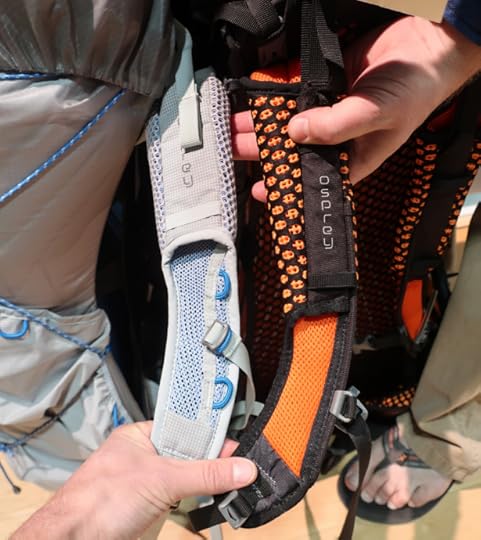
The shoulder straps on the Exos are about twice as thick as those on the Levity. Also, notice the sternum strap: the Exos has a conventional sliding rail, while the Levity is more minimal.
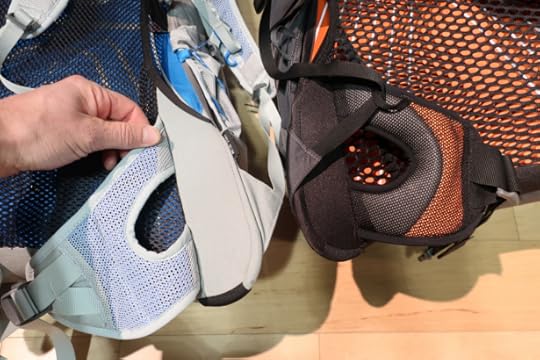
The Levity hipbelt is purely mesh and uses 20-mil webbing, while the Exos is lightly padded and has 35-mil webbing. This extra cushioning and surface area (and that on the shoulder straps) give the Exos more load carrying ability.
Fabrics
The main pack body of the Exos/Eja is made of 100d nylon, and its more abrasion-prone bottom uses heavier 210d nylon.
The pack body of the Levita/Lumina, meanwhile, is made of 30d silicone-impregnated nylon (“sil-nylon”), which is used frequently as a floor fabric in lightweight tents but which to me seems risky as a pack fabric: yes, it’s light; but it’s less durable than a comparably light Dyneema Composite Fabric (“Cuben”) or even a run-of-the-mill pack fabric like the 100d in the Exos/Eja.
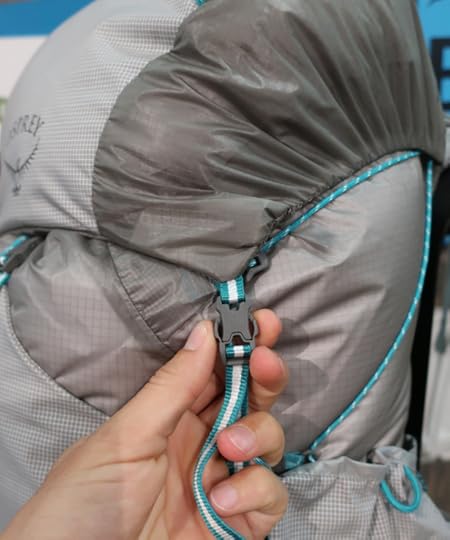
The Levity pack is made of 30d nylon, which strikes me as a risky pack fabric. At least it’s covered with a 200d x 210d “Chineema” in the most abrasion-prone areas. Also notice the narrow top lid attachment webbing, narrow SR buckle, and 2-mil compression strap cord. Osprey was obsessed with eliminating weight.
Thankfully, Osprey covered the most vulnerable sections of the pack — including the bottom, side pockets, rear pocket, and top lid — with a 210d nylon x 200d ultra-high-molecular-weight polyethylene (UHMWPE), which is essentially an unbranded equivalent to the Dyneema fabric used by, say, Mountain Laurel Designs and My Trail Company. At Sierra Designs we used a similar “Chineema” on the Flex Capacitor 40-60 Pack, in order to get high performance at less cost.
Osprey branded this fabric as NanoFly. It’s more durable, more water-resistant, and marginally lighter than the 210d used on the Exos/Eja. But it’s largely responsible for the $50 price premium between the two packs.
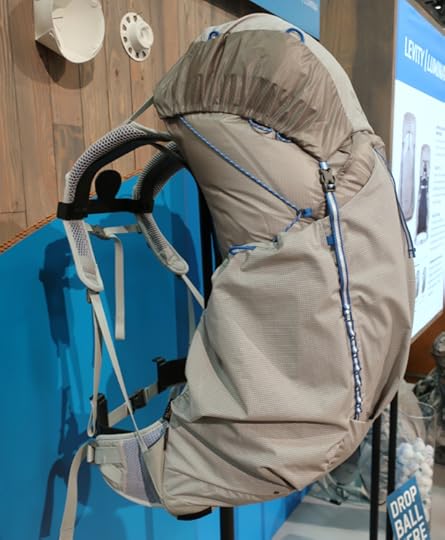
The delicate 30d sil-nylon is covered in the most abrasion-prone areas with a much more durable 210d x 200d “Chineema.”
Warranty
All Osprey products are backed with an All Mighty Guarantee, whereby it promises to repair any damage or defect free of charge (or replace the product if it’s beyond repair).
The Levity/Lumina is not intended for canyoneering in southern Utah, bushwhacking through Alaskan willow or Appalachian guard spruce, or scrambling on mineral-infused High Sierra granite, but the cost of such foolish behavior will be incurred by Osprey, not the user (at least once they’ve made it back to the trailhead). The Exos/Eja do not need to be babied as much.
Top lids
The Exos/Eja has a removable top lid. Osprey considered saving weight on the Levity/Lumina by excluding this feature, but ultimately kept it: it protects the main compartment from precipitation, improves compression, and creates a convenient pocket. However, it’s permanently attached, to eliminate the weight of some hardware and straps.
Pockets
Each pack has two side pockets, one rear pocket, and a top lid pocket. The Exos/Eja has one additional pocket on the underside of the top lid.
The side and rear pockets on the Exos/Eja are made partially with stretch mesh, which makes for a cleaner aesthetic. The Levity/Lumina pockets are dimensional (i.e. pre-shaped) because they are made of the 210d NanoFly, which has no stretch.
Trims
Osprey went gram-hunting on the Levity/Lumina trims. It removed several convenient and thoughtful — but ultimately unnecessary — features, like ice axe loops, sleeping pad straps, its Stow-on-the-Go trekking pole attachment system, the extra ring on its compression system pivots that allows for more nuanced adjustments, and even the 2-inch loop that opens up the hipbelt when the pack is picked up by a shoulder strap.
Trims on the Levity/Lumina that could not be removed were often scaled back relative to the Exos/Eja. For example, it has 15-mil webbing on the shoulder straps (vs 20), 20-mil webbing on the hipbelt (vs 35), 2-mil cord on the compression system (vs 5-mil webbing), and half-inch webbing for the top lid compression (vs three-quarter inch). I would describe some of these efforts as “stupid light,” but I admire Osprey’s weight obsession.
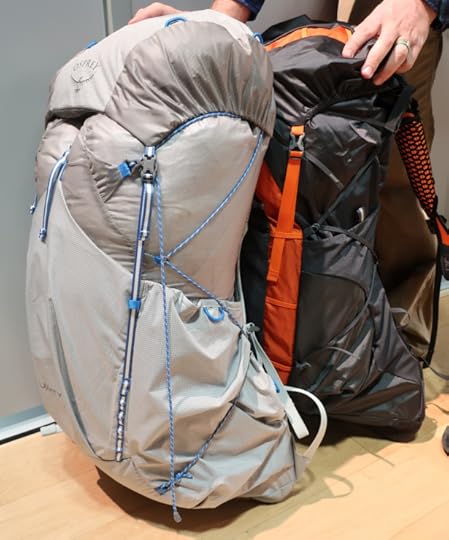
The Levity was pared down to the max. Nice-to-have but often extraneous features were removed, like ice axe loops. And the trims (mostly webbing and buckles) were all scaled down.
Price
The Lumina/Levity is about $50 more than the Exos/Eja: $250 and $270 for the 45 and 60, versus $180, $200, and $220 for for the 38, 48, and 58.
Ideal use
It sounds like the Levity/Lumina could have been priced for less, but it was intentionally not. Osprey believes that the higher price point will encourage newer backpackers — who tend to be more budget-conscious — to go with the Exos/Eja, which will better endure heavier loads and which does not need to be as babied. Chris specifically said, “The Levity/Lumina should not be someone’s first backpack.”
The Levity/Lumina is really designed for veteran backpackers, who generally have lighter kits and who take better care of their gear. Relatively speaking, the $50 premium is a small price to pay for a 12-oz weight-savings.
Questions about the Levity/Lumina or Exos/Eja? Leave a comment. If I can’t answer it, I’ll get the answer from Osprey.
Disclosure. This website is supported mostly through affiliate marketing, whereby for referral traffic I receive a small commission from select vendors, at no cost to the reader. This post contains affiliate links. Thanks for your support.
The post Osprey Levity/Lumina vs. Exos/Eja: What will you sacrifice for 12 oz? appeared first on Andrew Skurka.




